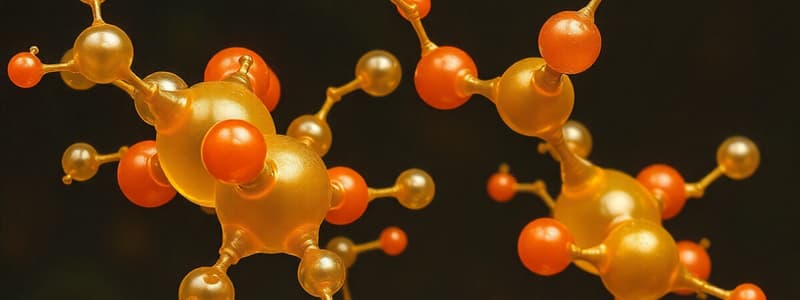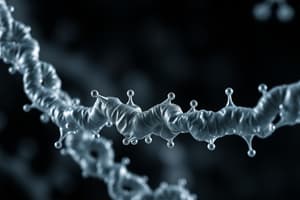Podcast
Questions and Answers
Lipids are important for storing ______ in the body.
Lipids are important for storing ______ in the body.
energy
The chains of amino acids that make up proteins are linked by ______ bonds.
The chains of amino acids that make up proteins are linked by ______ bonds.
peptide
Steroids, a type of lipid, are made up of ______ rings.
Steroids, a type of lipid, are made up of ______ rings.
carbon
Essential amino acids must be ______ through diet.
Essential amino acids must be ______ through diet.
Proteins can be composed of more than ______ amino acids.
Proteins can be composed of more than ______ amino acids.
Waxes are extremely ______ and prevent plants from losing water.
Waxes are extremely ______ and prevent plants from losing water.
Nucleic acids are composed of ______, which are the building blocks of genetic information.
Nucleic acids are composed of ______, which are the building blocks of genetic information.
The four levels of protein structure include primary, secondary, tertiary, and ______ structure.
The four levels of protein structure include primary, secondary, tertiary, and ______ structure.
Lipase is known as the ______ destroyer.
Lipase is known as the ______ destroyer.
Amylase is used to breakdown ______.
Amylase is used to breakdown ______.
Lactase breaks down ______, a sugar found in milk.
Lactase breaks down ______, a sugar found in milk.
Proteins are made up of linear chains of ______.
Proteins are made up of linear chains of ______.
The process of breaking down larger molecules into smaller ones is known as ______.
The process of breaking down larger molecules into smaller ones is known as ______.
Enzymes help speed up ______ in our bodies.
Enzymes help speed up ______ in our bodies.
Energy storage in organisms can involve ______ as a type of molecule.
Energy storage in organisms can involve ______ as a type of molecule.
DNA polymerase is essential for ______ replication.
DNA polymerase is essential for ______ replication.
The monomer of carbohydrates is called a ______.
The monomer of carbohydrates is called a ______.
Glucose and starch are examples of ______.
Glucose and starch are examples of ______.
Lipids serve functions such as energy storage and forming ______.
Lipids serve functions such as energy storage and forming ______.
The building blocks of proteins are called ______.
The building blocks of proteins are called ______.
Proteins act as catalysts in biochemical reactions, and are known as ______.
Proteins act as catalysts in biochemical reactions, and are known as ______.
Energy storage is one of the primary functions of ______.
Energy storage is one of the primary functions of ______.
Fats, phospholipids, and steroids are all types of ______.
Fats, phospholipids, and steroids are all types of ______.
Proteins can act as ______, which help in transporting substances in the body.
Proteins can act as ______, which help in transporting substances in the body.
The structural function of carbohydrates is exemplified by ______.
The structural function of carbohydrates is exemplified by ______.
Lipids can serve as ______ for signaling molecules in the body.
Lipids can serve as ______ for signaling molecules in the body.
Flashcards
Protein structure (amino acid chains)
Protein structure (amino acid chains)
Proteins are large molecules built from chains of amino acids, following a specific sequence determined by DNA. The sequence of amino acids dictates the protein's shape and function.
Peptide bonds
Peptide bonds
Peptide bonds are the chemical links between amino acids in a protein chain, formed by the joining of the acid group of one amino acid with the amine group of another.
Protein Denaturation
Protein Denaturation
Denaturation alters a protein's shape and function by disrupting its structure, primarily through heat, acid, base, or salt exposure.
Essential amino acids
Essential amino acids
Signup and view all the flashcards
Nucleic acid
Nucleic acid
Signup and view all the flashcards
Steroid structure
Steroid structure
Signup and view all the flashcards
Waxes
Waxes
Signup and view all the flashcards
Levels of protein structure
Levels of protein structure
Signup and view all the flashcards
Enzymes
Enzymes
Signup and view all the flashcards
Enzyme Function
Enzyme Function
Signup and view all the flashcards
Metabolism
Metabolism
Signup and view all the flashcards
Catabolism
Catabolism
Signup and view all the flashcards
Lipase
Lipase
Signup and view all the flashcards
Amylase
Amylase
Signup and view all the flashcards
DNA Polymerase
DNA Polymerase
Signup and view all the flashcards
Lactase
Lactase
Signup and view all the flashcards
Protein synthesis
Protein synthesis
Signup and view all the flashcards
mRNA
mRNA
Signup and view all the flashcards
tRNA
tRNA
Signup and view all the flashcards
rRNA
rRNA
Signup and view all the flashcards
Monosaccharide
Monosaccharide
Signup and view all the flashcards
Amino acid
Amino acid
Signup and view all the flashcards
DNA Structure
DNA Structure
Signup and view all the flashcards
Nucleotide
Nucleotide
Signup and view all the flashcards
Study Notes
Biomolecules
- Also known as organic molecules or macromolecules
- Composed of carbon, oxygen, nitrogen, phosphorus, sulfur, and hydrogen
- Serve as fuel for metabolism
- Crucial for cellular activities
- Key components for reproduction, growth, and sustenance in living organisms
Carbohydrates
- Composed of carbon, hydrogen, and oxygen atoms in a 1:2:1 ratio
- Formula: CH₂O
- Primarily monosaccharides, disaccharides, or polysaccharides
- Monosaccharides: basic units (glucose, fructose, galactose)
- Disaccharides: formed by joining monosaccharides through dehydration reactions
- Common disaccharides: maltose, sucrose, lactose
- Polysaccharides: long chains of glucose monomers
- Energy source for cellular respiration; create ATP
- Structural components e.g. cellulose(in plant cell walls) ,chitin(in fungi and exoskeletons), and peptidoglycan(in bacteria)
Lipids
- Composed of fatty acid monomers
- Diverse functions: structural support, energy storage, cell signaling
- Typically nonpolar and do not interact with water
- Triglycerides (fats): glycerol attached to three fatty acids
- Saturated fats: solid at room temperature(e.g., pork, beef, lard, cream,cheese)
- Unsaturated fats: liquid at room temperature (e.g., vegetable oils)
- Phospholipids: glycerol, two fatty acids, and a phosphate group
- Hydrophilic head, hydrophobic tails
- Critical for cell membranes
- Steroids: complex ring structures
- Involved in hormones (e.g., testosterone, estrogen, cortisol, Vitamin D, bile)
- Waxes: esters of fatty acids and alcohols
- Protection, preventing water loss (plant cuticles)
Proteins
- Chains of amino acids
- Found in every cell, involved in many bodily functions
- Amino acid sequence determined by DNA
- Peptides (short chains), polypeptides (longer chains), proteins (longer chains)
- Amino acids structure: central carbon, amine group, carboxyl group, and a variable side chain(R group) or functional group.
- Peptide bonds: join amino acids
- Levels of structure: primary, secondary, tertiary, quaternary
- Denaturation: alteration of a protein's shape due to heat, acids, bases, or other factors; changes function
- Essential amino acids: cannot be synthesized by the body(has to be consumed by eating)
- Nonessential amino acids: can be synthesized by the body
Nucleic Acids
- Polymers of nucleotides
- DNA (deoxyribonucleic acid)
- RNA (ribonucleic acid)
- Stores genetic information
- Transfers information for protein synthesis.
- Nucleotides structure: nitrogenous base, pentose sugar, phosphate group
- DNA double helix; RNA single stranded.
- DNA replication: crucial for cell division
- RNA types: mRNA (messenger), tRNA (transfer), rRNA (ribosomal)
Studying That Suits You
Use AI to generate personalized quizzes and flashcards to suit your learning preferences.
Related Documents
Description
Explore the essential biomolecules, including carbohydrates, lipids, and their key roles in living organisms. This quiz covers their structures, functions, and importance in metabolism and cellular activities. Test your understanding of these critical components for life.




